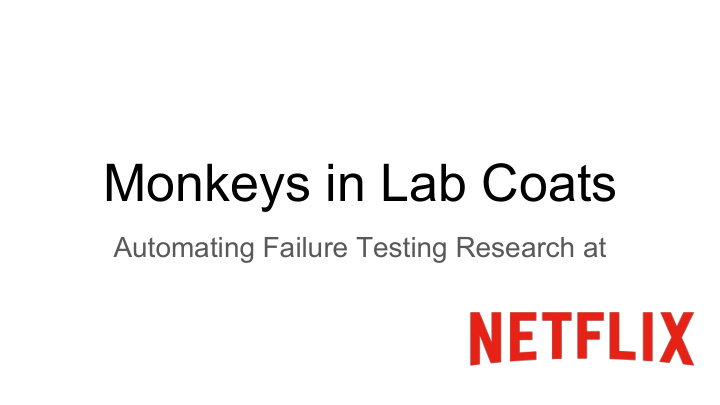



Monkeys in Lab Coats Automating Failure Testing Research at
The whole is greater than the sum of its parts. - Aristotle [Metaphysics]
The Professor vs The Practitioner Peter Alvaro Kolton Andrus Ex-Berkeley, Ex-Industry Ex-Netflix, Ex-Amazon Assistant Prof @ Santa Cruz ‘Chaos’ Engineer Misses the calm of PhD life Misses his actual pager Likes prototyping stuff Likes breaking stuff
Measures of Success Academic Industry H-Index Availability (i.e. 99.99% uptime) Grant warchest Number of Incidents Department ranking Reduce Operational Burden
An Unlikely Team?
Works Great! but ... it’s manual
Surely there is a better way ...
Free lunch?
The End? (Academia + Industry)
Let’s build it “Can we, pretty please?”
Freedom and Responsibility Core Value
Responsibility Academic Industry Prove that it works Show that it scales Find real bugs
Lineage Driven The Big Idea Fault Injection
What could possibly go wrong? Consider computation Search Space: involving 100 services 2 100 executions
“Depth” of bugs Single Faults Search Space: 100 executions
“Depth” of bugs Combination of 4 faults Search Space: 3M executions
“Depth” of bugs Combination of 7 faults Search Space: 16B executions
Random Search Search Space: 2 100 executions
Engineer-guided Search Search Space: ???
Fault-tolerance “is just” redundancy
How do we find the redundancy? Could a bad ‘thing’ ever happen? Why did a good ‘thing’ happen?
Lineage-driven fault injection The write is stable Why did a good thing happen? Stored on Stored on Consider its lineage . RepA RepB Bcast1 Bcast2 Client Client
Lineage-driven fault injection The write is stable Why did a good thing happen? Stored on Stored on Consider its lineage . RepA RepB What could have gone wrong? Faults are cuts in the lineage graph. Bcast1 Bcast2 Is there a cut that breaks all supports? Client Client
Lineage-driven fault injection The write is stable Why did a good thing happen? Stored on Stored on Consider its lineage . RepA RepB What could have gone wrong? Faults are cuts in the lineage graph. Bcast1 Bcast2 Is there a cut that breaks all supports? Client Client
What would have to go wrong? The write is stable (RepA OR Bcast1) Stored on Stored on RepA RepB Bcast1 Bcast2 Client Client
What would have to go wrong? The write is stable (RepA OR Bcast1) Stored on Stored on AND (RepA OR Bcast2) RepA RepB Bcast1 Bcast2 Client Client
What would have to go wrong? The write is stable (RepA OR Bcast1) Stored on Stored on AND (RepA OR Bcast2) RepA RepB AND (RepB OR Bcast2) Bcast1 Bcast2 Client Client
What would have to go wrong? The write is stable (RepA OR Bcast1) Stored on Stored on AND (RepA OR Bcast2) RepA RepB AND (RepB OR Bcast2) AND (RepB OR Bcast1) Bcast1 Bcast2 Client Client
Lineage-driven fault injection The write is stable Stored on Stored on RepA RepB Hypothesis: {Bcast1, Bcast2} Bcast1 Bcast2 Client Client
Search Space Reduction Each Experiment finds Reduces the a bug, OR Search space
The prototype system “Molly” Recipe: 4. REPEAT 1. Start with a successful outcome. Work backwards. 1. Success Fail 2. Ask why it happened: Lineage 3. Convert lineage to a boolean formula and solve 4. Lather, rinse, repeat Why? Solve Encode 2. Lineage 3. CNF
The Big Idea Meets Production
1. Start with a successful outcome 4. REPEAT 1. Success Fail Why? Solve Encode 2. 3. Lineage CNF
What is success?
“Start with the customer and work backwards” Leadership Principle
Lesson 1 Work backwards from what you know
2. Ask why it happened 4. REPEAT 1. Success Fail Why? Solve Encode 2. 3. Lineage CNF
Request Tracing
Request Tracing
Alternate Execution
Evolution over time
Redundancy through History
Lesson 2 Meet in the middle
3. Solve 4. REPEAT 1. Success Fail Why? Solve Encode 2. 3. Lineage CNF
A “small” matter of code
4. Lather, Rinse, Repeat 4. REPEAT 1. Success Fail Why? Solve Encode 2. 3. Lineage CNF
Turn the crank, right?
Idempotence
Bins and Balls Class 1 Request Class 2 r’ r Class 3 [...] Class n
Predicting Request Graphs Request Class n
Predicting Request Graphs Request Class n Some function f: Requests → Classes
Predicting Request Graphs Class n F( ) = Request
Solve the Machine Learning problem? or the Failure Testing one?
Simplest thing that will work?
Falcor Path Mapping ["bookmarks”, “recent”] ["playlist", 0, “name”] ["ratings"] => “bookmarks,playlist,ratings”
Lesson 3 Adapt the theory to the reality
Many moons passed...
YES! Does it work?
Case study: “Netflix AppBoot” Services ~100 2 100 (1,000,000,000,000,000,000,000,000,000,000) Search space (executions) Experiments performed 200 Critical bugs found 11
Future Work Search prioritization Richer device metrics Richer lineage collection Request class creation Exploring temporal Better experiment selection interleavings
Lessons Work backwards from what you know Meet in the middle Adapt the theory to the reality
Academia + Industry
Academia + Industry Academia Industry
Thank You! Peter Alvaro Kolton Andrus @palvaro @KoltonAndrus palvaro@ucsc.edu kolton@gremlininc.com
References ● Netflix Blog on ‘Automated Failure Testing’ http://techblog.netflix.com/2016/01/automated-failure-testing.html ● Netflix Blog on ‘Failure Injection Testing’ techblog.netflix.com/2014/10/fit-failure-injection-testing.html ● ‘Lineage Driven Fault Injection’ http://people.ucsc.edu/~palvaro/molly.pdf ● ‘Automating Failure Testing Research at Scale’ https://people.ucsc.edu/~palvaro/socc16.pdf
Photo Credits ● http://etc.usf.edu/clipart/4000/4048/children_7_lg.gif ● http://cdn.c.photoshelter.com/img-get2/I0000MIN8fL0q8AA/fit=1000x750/taiw an-hiking-river-tracing-walking.jpg ● http://i.imgur.com/iWKad22.jpg ● https://blogs.endjin.com/2014/05/event-stream-manipulation-using-rx-part-2/ ● http://youpivot.com/category/features/ ● https://www.cloudave.com/33427/boards-need-evolve-time/ ● https://www.linkedin.com/pulse/amelia-packager-missing-data-imputation-ram prakash-veluchamy
Recommend
More recommend